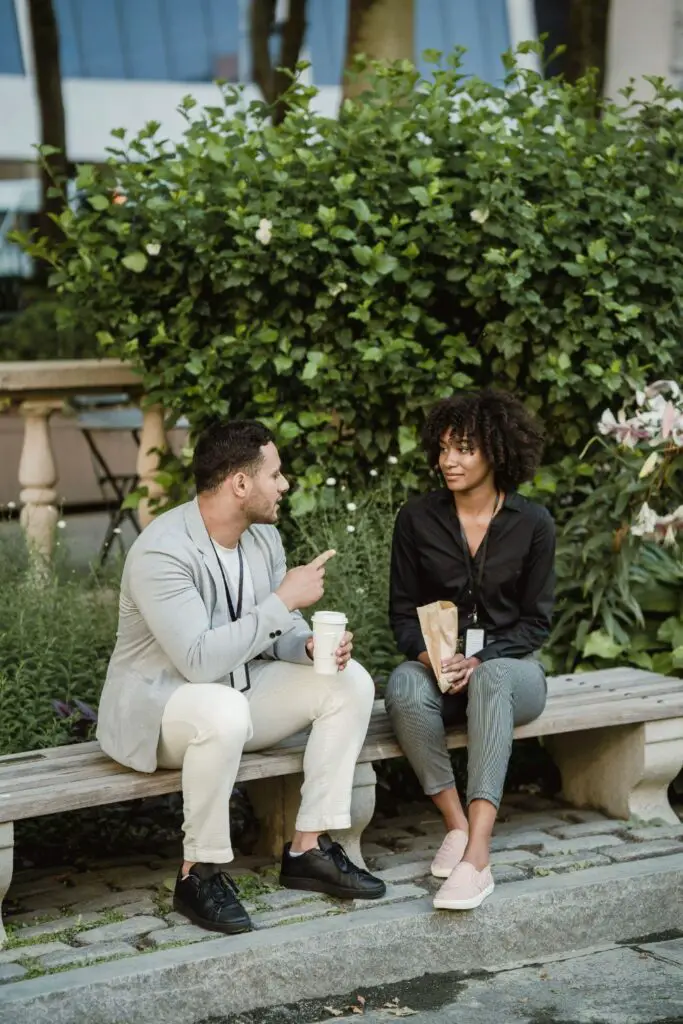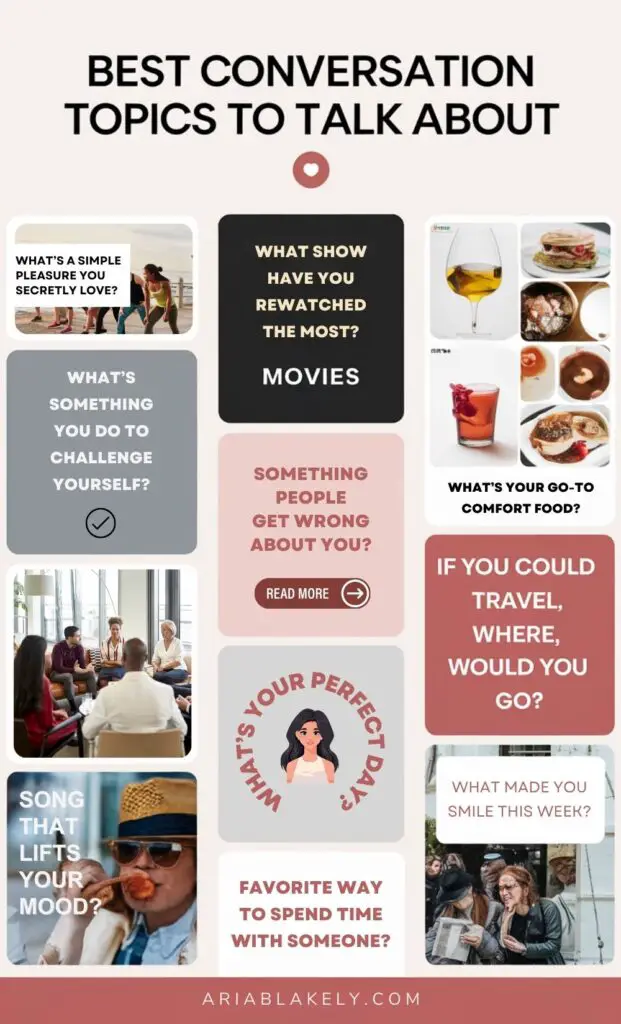You know that moment when you see someone you kind of know—maybe from work, or the gym, or your favorite overpriced coffee place—and you panic for a second like, “Do I smile? Do I wave? Do I suddenly pretend to text someone?”
Yeah. Same.
Talking to people shouldn’t feel like a performance… but for a lot of us, it kind of DOES.
Especially NOW, after years of remote work, online everything, and group chats replacing actual chats. It’s not that we don’t want to connect—it’s just that saying “hi” feels like a whole thing.
And if you’ve ever left a conversation replaying every word like a scene from a cringey sitcom, just know: you are not the only one.
But here’s the truth: you don’t need to be charming, hilarious, or extroverted to be good at talking to people.
You just need to be a little open, a little curious, and willing to feel a tiny bit awkward now and then.
This guide is here to help you talk to people—without the anxiety sweats.
We’ll walk through small, real-life ways to feel more confident and comfortable, even when your inner voice is screaming, “ABORT mission!”
Start With Someone You Know

If starting a conversation feels overwhelming, don’t worry—you don’t need to begin with a total stranger.
Start with someone familiar. Someone you already see often, like the receptionist at work, your neighbor who always walks her dog at 7am, or the cashier who recognizes your go-to coffee order.
These “lightly familiar” faces are the PERFECT practice ground—because the stakes are low, but the impact can be surprisingly big.
Think about it: You’re not trying to become besties right away.
You’re just building up the muscle of saying something instead of staying silent.
Even something as simple as:
- “Hey! I always love your lipstick color.”
- “Busy day at the front desk today?”
- “Your dog is SO well-behaved—what’s your secret?”
See? Nothing groundbreaking. But what these tiny moments DO is help you ease into interaction without the pressure of a deep conversation.
It’s like stretching before a workout—you’re warming up your social skills.
And here’s the thing: connection doesn’t always start with deep talk. It often starts with “Hey, how’s your day going?” And maybe it ends there—and that’s fine.
You said something. You reached out. You showed up. That’s meaningful.
We know how easy it is to think, “She probably doesn’t want to talk” or “I’ll sound weird.” But the truth?
Most people are craving connection too—they’re just waiting for someone else to make the first move.
So let’s make it easy on ourselves. Start with someone you know. Smile. Say hi. Let it be small, and let that be enough.
You might also like: 301 Deep, Funny, and Flirty Questions to Ask Your Boyfriend
Keep It Super Simple

We tend to overthink conversations like we’re prepping for a TED Talk—but real-life connection? It’s way more casual than we give it credit for.
You don’t need a clever one-liner or some magical “in.” You just need to say something—anything—to open the door. And honestly? The more simple and honest, the better.
Try things like:
👉 “Hey, how’s your week going?”
👉 “That lunch smells amazing—what is it?”
👉 “I don’t know about you, but I’m ready for Friday already.”
See how normal that is? These little lines might not seem like much, but they create space for someone to respond—and that’s the whole goal.
It’s not about dazzling someone with your social genius. It’s about making room for connection.
And let’s be real—we all have that voice in our head saying, “That sounds dumb,” or “They’ll think I’m awkward.”
But you know what? We’ve NEVER walked away from a kind, friendly “hello” and thought badly of the person who said it.
Ask About Them (Not Their Job)

Here’s a little truth no one talks about: asking someone what they do for a living can be a total vibe-killer.
Not because it’s rude—it’s just… TIRED. Most of us are more than our jobs, and let’s be honest, not everyone wants to talk about work after work.
So instead of defaulting to “What do you do?”, try asking something that gives them a chance to talk about what actually lights them up.
Try:
👉 “What do you usually do for fun on the weekends?”
👉 “Are you watching anything good right now?”
👉 “What’s something you’re into lately?”
See the difference? These kinds of questions feel so MUCH more human.
They invite real answers, spark stories, and take the pressure off that whole “I need to sound impressive” thing.
And if you’re thinking, “But what if it gets awkward?”—that’s totally fair.
The trick is to stay curious. You’re not trying to “get through” the conversation, you’re just exploring it.
If they mention a show, ask what they love about it. If they say they love hiking, ask where their favorite spot is.
People want to feel seen. And the best way to help someone feel seen is to show them that you’re genuinely interested—not in their résumé, but in THEM.
Practice in Low-Stakes Places

Look, we’re not starting with a networking event or someone you have a huge crush on.
We’re starting small—like, grocery store small.
The goal isn’t to have a deep, meaningful conversation with everyone you meet. It’s just to get comfortable speaking up.
Low-stakes places are golden for this. Think:
✔️ Chatting with the barista while you wait for your latte
✔️ Saying hi to someone in the elevator
✔️ Complimenting the person next to you in yoga class (“Your mat is so cute!” works wonders)
These are situations where the convo naturally ends after a few seconds—no pressure to keep it going, no awkward exit.
It’s like social training wheels, and it helps your brain learn that initiating a conversation doesn’t have to be scary.
We’ve even heard from women who intentionally practiced small talk once a day—like a personal challenge.
Compliment someone’s outfit. Ask the cashier how their shift is going. Comment on the weather (yes, it’s basic—but still works!).
Over time, these LITTLE moments build confidence. And that confidence? It starts to show up in bigger ways—at work, in new friend groups, on first dates, you name it.
Don’t Panic Over Pauses

You’re talking to someone… things are going fine… and then—SILENCE.
Cue the internal freak-out: “Did I say something weird? Should I fill the space? Do I smile awkwardly and walk away forever?”
Take a deep breath, friend. Pauses are completely normal. In fact, they’re part of the rhythm of conversation.
We’ve all been there—trying to fill every second so it doesn’t feel awkward.
But the truth is, some of the best conversations have quiet moments. It’s not a failure. It’s a breather.
It’s space to think, reflect, or even smile at each other.
What matters more than avoiding silence is how you handle it. If there’s a little pause, try gently restarting with something simple like:
- “That totally reminded me of something—”
- “I always forget what I was going to say mid-sentence. Does that happen to you too?”
- “By the way, I meant to ask…”
These phrases don’t need to be polished. They just keep things moving without pressure.
Also—let’s normalize this: Not EVERY conversation will flow perfectly.
Sometimes it’ll feel clunky, sometimes you’ll trip over your words, and sometimes you’ll say “you too!” when someone tells you to enjoy your meal. (We’ve all done it. Still cringe.)
But that doesn’t mean you’re bad at talking to people. It means you’re human.
Use Your Face and Body

Here’s a secret most people forget: you don’t have to say a word to be part of the conversation.
Your body language does a LOT of the talking for you.
Ever had a chat where someone looked down the whole time or didn’t smile once?
Kinda makes you want to wrap it up fast, right? Now think of someone who made eye contact, nodded while you spoke, or smiled when you shared something—even something small.
That kind of presence makes you feel seen.
And guess what? You can be that kind of person, too—without saying anything extra.
Try this:
📌 Make soft eye contact (you don’t need to stare like it’s a staring contest—just be open)
📌 Nod while they talk to show you’re listening
📌 Smile when it feels natural—especially when you’re greeting someone or reacting to what they said
📌 Lean in slightly when someone’s sharing something personal or interesting
These little cues help people feel like you’re WITH them in the conversation—and that makes you feel more connected, too. It’s a two-way thing.
If this feels awkward at first, that’s totally okay. Sometimes, especially when we’re anxious or unsure, we forget to even breathe, let alone smile.
But the more you practice being physically present, the more natural it becomes.
You might also like: 10 Simple Steps to Reset Your Life
Know When To Leave It

Okay, let’s get real for a second: not every conversation is going to click.
And that’s not a reflection of you or your social skills—it’s just life.
Sometimes people are distracted, tired, or just not in the mood to chat.
Sometimes you’re the one feeling that way. And you know what? That’s okay.
We don’t need to force connection to prove we’re friendly. In fact, trying TOO hard to keep a flat convo going can leave you feeling more drained than fulfilled.
So how do you know when to wrap it up?
- If their responses are short and they’re not asking anything back
- If they keep checking their phone or looking around
- If the energy just feels… off
Instead of panicking or spiraling (“Did I say something wrong?”), trust the vibe.
Politely wrap things up and move on with your day. Try something like:
✅ “It was great talking to you—hope you have a good one!”
✅ “Well, I’ll let you get back to it. Nice catching up for a sec!”
✅ Simple, kind, and respectful. No drama. No overthinking.
And remember: your worth isn’t measured by how many conversations go perfectly.
Sometimes a quick smile and a kind word are enough. Sometimes nothing clicks and you try again another day.
Keep a Few Go-To Starters Handy

You know that moment when your brain completely blanks and you think, “I should say something… but what?” Yeah, we’ve all been there.
That’s why it helps to have a little mental cheat sheet of conversation starters READY to go.
You don’t need a script—just a few easy, natural phrases you can pull out when your social battery is low or your nerves are high.
Here are some favorites that work almost anywhere:
👉 “I love your [bag/jacket/earrings]—where’d you get it?”
👉 “That looks so good—what are you eating?”
👉 “Can I just say—you’ve got such a great sense of style. That outfit is doing all the right things.”
👉 “You seem really familiar. I’m wondering if we’ve met… or maybe I just have great taste in people.”
👉 “Sorry if this is random, but I like your presence. It’s grounding.”
Simple, right? These are openers, not interviews.
You’re just giving the other person something to respond to—and most people are grateful you made the first move.
Tailor your starter to your environment.
- At a workout class? “Have you done this one before?”
- At a party? “How do you know the host?”
- At work? “How’s your week going so far?”
And if a conversation doesn’t take off? No big deal. You tried. That small moment of courage still counts.
The more you practice, the less you’ll need to rely on these—and one day, you’ll find yourself chatting without even thinking about it.
But for now, having a few phrases in your pocket is like having an emotional safety net. And there’s NOTHING wrong with that.
Stick to Common Ground

When you’re just getting to know someone, it’s easy to start talking about YOUR favorite things—your latest book obsession, your workout routine, or that one conspiracy theory you swear is true (okay, maybe that one’s better left out).
But here’s the thing: great conversations are built on shared comfort, not just shared interests.
In the early moments—especially with someone new—it helps to keep the topic light, open, and mutually safe.
Not every conversation has to dive into your deepest thoughts or hottest takes.
Instead, try talking about:
📌 A local event or festival you’re both attending
📌 A show or movie everyone seems to be watching lately
📌 The weather (yes, it’s basic—but it works)
📌 What’s going on in the environment you’re both in (the line, the music playing, the food, etc.)
These types of topics give you something to connect over without risking discomfort or disagreement.
Because let’s be real—you don’t want the first thing someone knows about you to be your strongest opinion on politics, parenting, or pineapple on pizza.
You’re not dumbing things down—you’re BUILDING a bridge. And that’s how real conversations start.
Listen Like You Actually Care (Because You Should)

Ever been mid-sentence and someone jumps in to finish your thought—or worse, changes the subject altogether? It stings a little, right?
It feels like what you were saying didn’t really matter.
That’s why one of the best ways to hold a conversation is also the simplest: let the other person finish talking.
It sounds obvious, but you’d be surprised how often people cut each other off without even realizing it—especially when they’re nervous or excited.
But when you pause, give someone space, and truly listen? That’s where connection happens.
You’re showing them:
“Hey, I’m not just waiting for my turn—I’m actually interested in what you’re saying.”
And when it’s your turn to speak? Instead of jumping in with your own story or opinion right away, try asking a genuine question about what they just said:
- “How did that make you feel?”
- “What happened after that?”
- “That sounds intense—what would you have done differently?”
These kinds of responses help keep the conversation flowing naturally, without making it all about you.
They show that you’re listening not just with your ears, but with your heart.
And here’s the bonus: the more people feel heard around you, the more they’ll open up.
You become the kind of person others feel safe with. That’s powerful.
So slow down. Listen fully. Ask sincerely. And watch how your conversations shift from surface-level to SOMETHING real.
You might also like: 30-Day Self-Improvement Challenge to Help You Improve
For You
If no one’s told you this before, hear it now: you are not too awkward, too quiet, too much, or too late to learn how to connect with people.
You’re exactly where you need to be.
It’s easy to believe that being good at conversations is something other people just NATURALLY know how to do.
But the truth? It’s a skill. And like any skill, it can be practiced, shaped, and strengthened over time—with gentleness, curiosity, and a little bit of bravery.
We don’t need you to be perfect. We just need you to keep showing up.
Say the first word, even if your voice shakes. Ask the question, even if you’re not sure how it’ll land.
Let someone finish their thought. Smile, nod, pause, and listen like it matters—because it does.
And when it feels a little awkward? That’s okay. Awkward doesn’t mean you failed. It means you’re human—and you’re trying.
So here’s your gentle nudge: start small, and start somewhere.
Say hi to the coworker you usually avoid eye contact with. Compliment a stranger at the grocery store. Use one of your go-to openers, even if you fumble it.
Because every little moment of connection builds confidence. And confidence, over time, becomes comfort. You’ve got this! 💛


